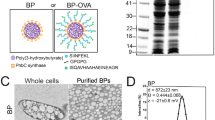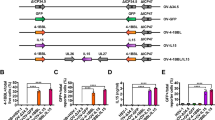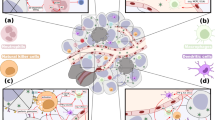Abstract
We have examined the potential of recombinant Escherichia coli expressing listeriolysin O (LLO) to deliver tumour antigens to dendritic cells (DCs) for cancer immunotherapy. Using OVA as a model tumour antigen, we have shown in murine DCs that E. coli expressing cytoplasmic LLO and OVA proteins can deliver the OVA Kb-restricted epitope SIINFEKL for MHC class I presentation. In contrast, when E. coli expressing OVA alone were used, MHC class II presentation of the OVA 323-339 I-Ab-restricted peptide was predominant. When injected in vivo, DCs pulsed with E. coli expressing LLO and OVA induced production of cytotoxic T-lymphocytes capable of lysing an OVA-expressing melanoma cell line (B16-OVA) and resulted in suppression of tumour growth following challenge with B16-OVA. Immunisation of mice by direct injection of E. coli LLO/OVA provided a more potent anti-tumour response, resulting in complete protection in 75% of mice. Injection of live bacteria was not necessary as immunisation with paraformaldehyde-fixed E. coli LLO/OVA provided an even stronger anti-tumour response against B16-OVA. Altogether, our data highlight the potential of this system as a novel and efficient strategy for tumour immunotherapy.
This is a preview of subscription content, access via your institution
Access options
Subscribe to this journal
Receive 6 print issues and online access
$259.00 per year
only $43.17 per issue
Buy this article
- Purchase on SpringerLink
- Instant access to full article PDF
Prices may be subject to local taxes which are calculated during checkout






Similar content being viewed by others
References
Timmerman JM, Levy R . Dendritic cell vaccines for cancer immunotherapy Annu Rev Med 1999 50: 507–529
Fong L, Engleman EG . Dendritic cells in cancer immunotherapy Annu Rev Immunol 2000 18: 245–273
Schadendorf D, Nestle FO . Autologous dendritic cells for treatment of advanced cancer – an update Rec Res Cancer Res 2001 158: 236–248
Nestle FO et al. Vaccination of melanoma patients with peptide- or tumor lysate-pulsed dendritic cells Nat Med 1998 4: 328–332
Kugler A et al. Regression of human metastatic renal cell carcinoma after vaccination with tumor cell-dendritic cell hybrids Nat Med 2000 6: 332–336
Panelli MC et al. Phase 1 study in patients with metastatic melanoma of immunization with dendritic cells presenting epitopes derived from the melanoma-associated antigens MART-1 and gp100 J Immunother 2000 23: 487–498
Thurner B et al. Vaccination with mage-3A1 peptide-pulsed mature, monocyte-derived dendritic cells expands specific cytotoxic T cells and induces regression of some metastases in advanced stage IV melanoma J Exp Med 1999 190: 1669–1678
Rock KL, Goldberg AL . Degradation of cell proteins and the generation of MHC class I-presented peptides Annu Rev Immunol 1999 17: 739–779
Dallal RM, Lotze MT . The dendritic cell and human cancer vaccines Curr Opin Immunol 2000 12: 583–588
Falo LD Jr et al. Targeting antigen into the phagocytic pathway in vivo induces protective tumour immunity Nat Med 1995 1: 649–653
Cho HJ et al. Immunostimulatory DNA-based vaccines induce cytotoxic lymphocyte activity by a T-helper cell-independent mechanism Nat Biotechnol 2000 18: 509–514
Dhodapkar MV et al. Antigen-specific inhibition of effector T cell function in humans after injection of immature dendritic cells J Exp Med 2001 193: 233–238
Winzler C et al. Maturation stages of mouse dendritic cells in growth factor-dependent long-term cultures J Exp Med 1997 185: 317–328
Henderson RA, Watkins SC, Flynn JL . Activation of human dendritic cells following infection with Mycobacterium tuberculosis J Immunol 1997 159: 635–643
Rescigno M et al. Bacteria-induced neo-biosynthesis, stabilization, and surface expression of functional class I molecules in mouse dendritic cells (published erratum appears in Proc Natl Acad Sci USA 1999; 96: 9666) Proc Natl Acad Sci USA 1998 95: 5229–5234
Higgins DE, Shastri N, Portnoy DA . Delivery of protein to the cytosol of macrophages using Escherichia coli K-12 Mol Microbiol 1999 31: 1631–1641
Fidler IJ . Biological behavior of malignant melanoma cells correlated to their survival in vivo Cancer Res 1975 35: 218–224
Karttunen J, Sanderson S, Shastri N . Detection of rare antigen-presenting cells by the LacZ T cell activation assay suggests an expression cloning strategy for T cell antigens Proc Natl Acad Sci USA 1992 89: 6020–6024
Braciale TJ et al. Antigen presentation pathways to class I and class II MHC-restricted T lymphocytes Immunol Rev 1987 98: 95–114
Lappin MB et al. Analysis of mouse dendritic cell migration in vivo upon subcutaneous and intravenous injection Immunology 1999 98: 181–188
Banchereau J, Steinman RM . Dendritic cells and the control of immunity Nature 1998 392: 245–252
Banchereau J et al. Immunobiology of dendritic cells Annu Rev Immunol 2000 18: 767–811
Guzman CA et al. Apoptosis of mouse dendritic cells is triggered by listeriolysin, the major virulence determinant of Listeria monocytogenes Mol Microbiol 1996 20: 119–126
Rosenblum MG, Horn SA, Cheung LH . A novel recombinant fusion toxin targeting HER-2/NEU-over-expressing cells and containing human tumor necrosis factor Int J Cancer 2000 88: 267–273
Kawakami Y et al. Production of recombinant MART-1 proteins and specific antiMART-1 polyclonal and monoclonal antibodies: use in the characterization of the human melanoma antigen MART-1 J Immunol Meth 1997 202: 13–25
Fenton RG et al. Induction of T cell immunity against Ras oncoproteins by soluble protein or Ras-expressing Escherichia coli J Natl Cancer Inst 1995 87: 1853–1861
Alderson MR et al. Expression cloning of an immunodominant family of Mycobacterium tuberculosis antigens using human CD4(+) T cells J Exp Med 2000 191: 551–560
Sanderson S, Campbell DJ, Shastri N . Identification of a CD4+ T cell-stimulating antigen of pathogenic bacteria by expression cloning J Exp Med 1995 182: 1751–1757
Hugo P et al. A cell line that can induce thymocyte positive selection Nature 1992 360: 679–682
Inaba K . Generation of large numbers of dendritic cells from mouse bone marrow cultures supplemented with granulocyte/macrophage colony-stimulating factor J Exp Med 1992 176: 1693–1702
Lyons AB, Parish CR . Determination of lymphocyte division by flow cytometry J Immunol Meth 1994 171: 131–137
Acknowledgements
This work was supported by Cancer Research UK and ‘Help Hammer Cancer’. We would like to thank Del Watling and Sandra Peak for their assistance with in vivo work.
Author information
Authors and Affiliations
Rights and permissions
About this article
Cite this article
Radford, K., Higgins, D., Pasquini, S. et al. A recombinant E. coli vaccine to promote MHC class I-dependent antigen presentation: application to cancer immunotherapy. Gene Ther 9, 1455–1463 (2002). https://doi.org/10.1038/sj.gt.3301812
Received:
Accepted:
Published:
Issue date:
DOI: https://doi.org/10.1038/sj.gt.3301812
Keywords
This article is cited by
-
Harnessing synthetic biology for advancing RNA therapeutics and vaccine design
npj Systems Biology and Applications (2023)
-
Recent trends and advances in microbe-based drug delivery systems
DARU Journal of Pharmaceutical Sciences (2019)
-
Targeting ideal oral vaccine vectors based on probiotics: a systematical view
Applied Microbiology and Biotechnology (2019)
-
Inhibiting avian influenza virus shedding using a novel RNAi antiviral vector technology: proof of concept in an avian cell model
AMB Express (2016)
-
A Safe Bacterial Microsyringe for In Vivo Antigen Delivery and Immunotherapy
Molecular Therapy (2013)



